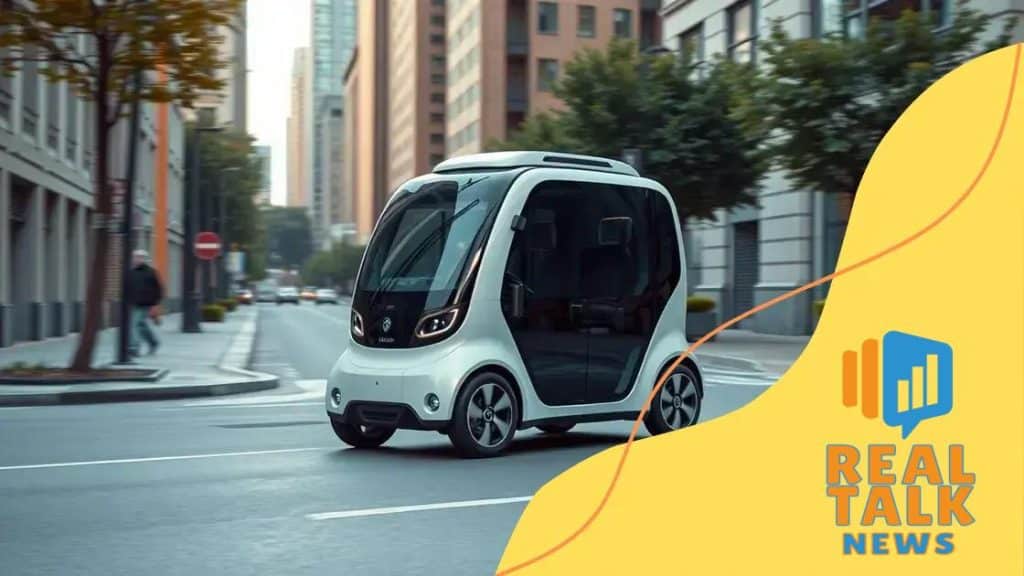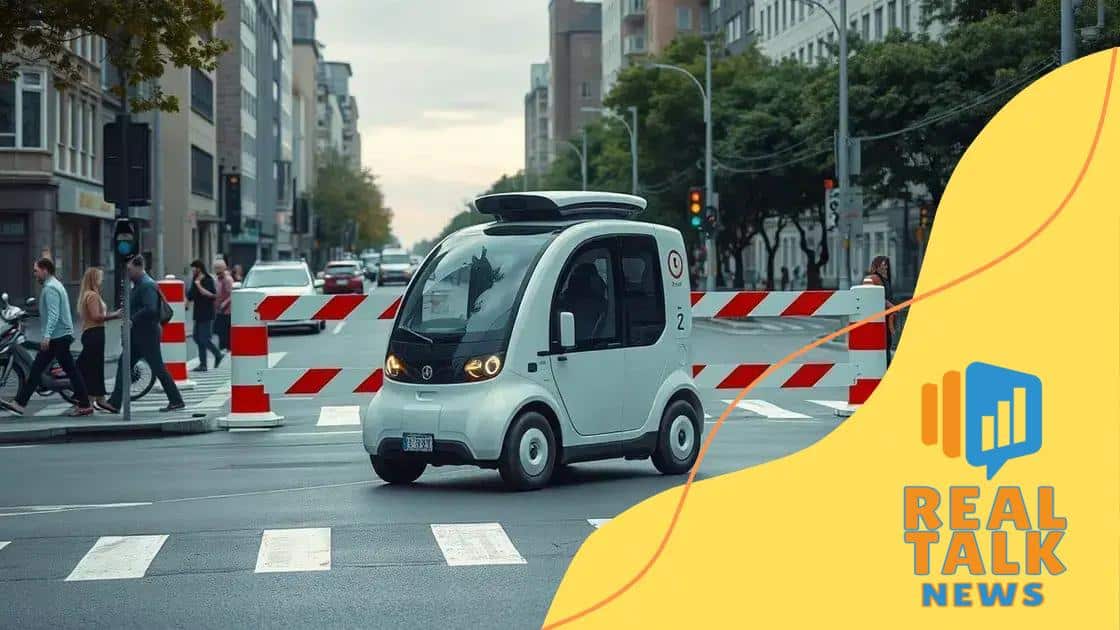The rise of autonomous delivery vehicles in e-commerce

The rise of autonomous delivery vehicles in e-commerce enhances efficiency and reduces costs while presenting challenges such as safety and regulatory issues that must be addressed for wider adoption.
The rise of autonomous delivery vehicles in e-commerce is changing how products reach us. Have you ever wondered how these innovative solutions could shape your shopping experience?
Understanding autonomous delivery vehicles
Understanding autonomous delivery vehicles is essential as they start to play a crucial role in modern logistics. These vehicles use advanced technology to navigate and deliver goods with minimal human intervention. But how do they actually work?
How Autonomous Delivery Vehicles Function
Autonomous delivery vehicles rely on a blend of sensors, cameras, and artificial intelligence. They scan their surroundings in real-time to identify obstacles, routes, and traffic signals. This technology allows them to operate safely even in complex environments.
Key Components of Autonomous Delivery Systems
- GPS and mapping technology for navigation
- Sensors that detect nearby objects
- Artificial intelligence for decision-making
- Communication systems for remote monitoring
These components work together to ensure that the vehicle can make informed choices during its journey. Imagine a world where you can order a package, and an autonomous vehicle brings it right to your doorstep without delay.
As these vehicles become more advanced, their role in e-commerce is expected to expand. Companies are investing in this technology, predicting a future where delivery times shrink significantly. The convenience and efficiency of autonomous delivery vehicles may redefine how we shop online.
Challenges in Autonomous Delivery Technology
Despite their benefits, there are obstacles to overcome. Safety, regulatory compliance, and consumer acceptance are just a few challenges. Companies must ensure their vehicles can navigate safely while adhering to local laws.
- Addressing safety concerns is vital
- Developing regulations for autonomous vehicle operations
- Educating consumers on the benefits
By tackling these issues, the industry can pave the way for a smoother transition to using autonomous delivery vehicles.
In conclusion, understanding autonomous delivery vehicles not only highlights technological advancements but also prepares us for a seamless integration into our daily lives.
Benefits of using autonomous delivery in e-commerce
The benefits of using autonomous delivery in e-commerce are becoming increasingly evident as technology advances. These vehicles offer unique advantages that can enhance both operations and customer satisfaction. Let’s explore some of these key benefits.
Enhanced Efficiency
Using autonomous delivery vehicles allows companies to streamline their logistics. They can operate continuously without the need for breaks, reducing delivery times significantly. This efficiency not only meets customer expectations but can also lower operational costs.
Cost Savings
With reduced labor costs and the ability to operate around the clock, businesses see substantial savings. Companies can allocate their resources more wisely, redirecting funds to improve other areas of their business. Additionally, autonomous vehicles minimize errors and improve order accuracy.
- Lower transportation costs
- Fewer staffing requirements
- Reduced fuel consumption
The combination of these factors contributes to an overall increase in profitability for e-commerce businesses.
Customer experience is another area that greatly benefits from autonomous delivery. Fast and reliable delivery builds trust with consumers. Imagine placing an order and having it arrive within hours—this level of service enhances customer loyalty. Happy customers often lead to repeat business and positive word-of-mouth.
Sustainability Advantages
Many autonomous delivery vehicles are designed with eco-friendliness in mind. By utilizing electric power and efficient routing, they can significantly reduce carbon footprints. Businesses that adopt sustainable practices not only contribute to environmental health but also appeal to increasingly eco-conscious consumers.
- Lower emissions contribute to a cleaner environment
- Innovative designs focused on sustainability
As consumers become more aware of their choices, sustainability can be a competitive advantage in the crowded e-commerce market.
The adoption of autonomous delivery systems seems to be the next logical step in the evolution of logistics. Businesses are not just improving efficiency and cost; they are setting new standards for what customers expect from their delivery services.
Challenges faced by autonomous delivery systems

The challenges faced by autonomous delivery systems present significant hurdles for companies looking to implement this technology. While the potential benefits are immense, several issues must be addressed for widespread adoption.
Safety Concerns
One of the primary challenges is ensuring the safety of both the vehicles and the public. Autonomous delivery vehicles must navigate complex environments with pedestrians, cyclists, and other vehicles. Even with advanced sensors and AI, accidents can occur. Ensuring that these vehicles can operate safely in all conditions remains a top priority.
Regulatory Hurdles
Another significant challenge is the lack of clear regulations governing the use of autonomous delivery vehicles. Different regions may have varying laws, making it difficult for companies to implement their systems. Without consistent standards, the rollout of this technology can be slow and cumbersome.
- Need for clear guidelines for testing
- Regulation on where these vehicles can operate
- Insurance and liability issues to consider
As regulators develop frameworks, businesses must navigate these complexities carefully to avoid potential legal pitfalls.
Public acceptance also plays a crucial role in the success of autonomous delivery systems. Many consumers may feel uneasy about interacting with a robot delivering their packages. Building trust through education and successful pilot programs can help alleviate these concerns.
Technical Limitations
Despite advances in technology, autonomous delivery systems face technical limitations. For example, weather conditions like rain or snow can affect sensor performance. Moreover, handling unexpected obstacles in real-time remains a challenge, impacting the delivery efficiency.
- Need for continuous improvements in AI algorithms
- Enhancements in sensor technology required
- Focusing on navigation in less structured environments
These technical factors hinder the effectiveness of autonomous systems and remain a barrier to market entry.
By identifying and addressing these challenges, companies can better prepare for the future of autonomous delivery systems. The technology shows promise, but overcoming these obstacles is crucial for successful implementation.
Technological advancements enabling autonomous deliveries
Technological advancements enabling autonomous deliveries are rapidly changing the landscape of logistics. Innovations in various fields are making it possible for these vehicles to navigate effectively and safely.
Artificial Intelligence and Machine Learning
At the core of autonomous delivery systems is artificial intelligence (AI). AI algorithms analyze vast amounts of data to help vehicles make decisions in real-time. For instance, machine learning enables these systems to improve their performance by learning from experience and past deliveries.
Advanced Sensors and Mapping Technologies
Another key advancement comes from sensors, which are crucial for safe navigation. These sensors, including lidar and cameras, gather detailed information about the surroundings. This data allows autonomous vehicles to create accurate maps of their environment.
- Lidar for 3D mapping of the surroundings
- Cameras for object recognition and navigation
- Radar for detecting distance and speed of nearby objects
These technologies work together to provide the vehicle with a comprehensive view, ensuring it can react promptly to changes in its environment.
Additionally, improvements in communication networks, such as 5G, enhance real-time data sharing. This allows autonomous delivery vehicles to communicate with each other and nearby infrastructure. By connecting to broader networks, these vehicles can optimize their routes and avoid obstacles.
Electric Vehicle Technology
The shift towards electric vehicle technology is also significant for autonomous deliveries. Electric vehicles are not only eco-friendly, but their design often includes features that support automation. Improved battery life gives these vehicles the range they need to complete deliveries without constant recharging.
- Lower maintenance costs due to fewer moving parts
- Quieter operation, reducing noise pollution in urban areas
- Environmentally friendly options align with consumer preferences
This focus on sustainability resonates with consumers, who increasingly prefer businesses that adopt greener practices.
Overall, the combination of AI, advanced sensors, enhanced communication networks, and electric vehicle technology are driving the future of autonomous deliveries. As these innovations continue to evolve, they promise to enhance delivery efficiency and reshape the logistics landscape.
Future trends in delivery vehicle automation
Future trends in delivery vehicle automation are shaping the logistics landscape significantly. As technology continues to evolve, we can expect various exciting advancements that will make deliveries faster and more efficient.
Increased Use of Drones
One prominent trend is the rising use of drones for delivery. Drones can cover short distances quickly, making them ideal for delivering small packages. They can easily navigate around obstacles such as traffic, which reduces delivery time.
Improved Integration with Smart Cities
Another trend is the integration of automated delivery systems with smart city infrastructure. With the growth of IoT (Internet of Things), delivery vehicles will communicate with traffic signals and other city services. This will allow them to choose optimal routes, reducing delays and improving efficiency.
- Real-time data sharing for better route optimization
- Communication with smart traffic lights for smooth navigation
- Surveillance data for enhanced safety during deliveries
This synergy can create a seamless experience for both companies and customers, ensuring that packages arrive on time.
Additionally, advancements in artificial intelligence will enhance vehicle adaptability. Future automated vehicles will be able to learn from their environments and improve their performance over time. This means they will better handle unexpected situations, making deliveries safer.
Focus on Sustainability
Sustainability will be at the forefront of future delivery vehicle trends. Many companies will aim to use electric vehicles, reducing carbon emissions. The use of eco-friendly materials and designs will also increase, aligning with growing consumer demand for responsible practices.
- Development of renewable energy sources for vehicle charging
- Innovative designs that minimize waste
- Strategies for balancing efficiency and environmental impact
As more consumers prefer environmentally sustainable options, businesses will need to adapt to these trends to stay competitive.
Overall, the future of delivery vehicle automation holds many possibilities. From drone deliveries to smart city integrations and sustainability efforts, these trends will not only enhance efficiency but also improve the overall customer experience in the logistics sector.
rise of autonomous delivery vehicles is transforming the e-commerce landscape. With advancements in technology, these vehicles promise improved efficiency, cost savings, and enhanced customer experiences. However, challenges like safety and regulatory hurdles still exist. Looking ahead, future trends will likely shape the automation of deliveries even further, emphasizing sustainability and smart city integration. As companies embrace these innovations, the future of delivery holds great potential for everyone involved.
FAQ – Frequently Asked Questions about Autonomous Delivery Vehicles
What are autonomous delivery vehicles?
Autonomous delivery vehicles are self-driving vehicles designed to transport goods with minimal human involvement, using advanced technologies like AI and sensors.
How do autonomous delivery vehicles enhance efficiency?
These vehicles operate continuously without breaks, optimizing delivery routes and reducing overall delivery times, which improves customer satisfaction.
What challenges do autonomous delivery systems face?
Key challenges include safety concerns, regulatory hurdles, and public acceptance, which must be addressed for broader adoption.
What future trends can we expect in delivery vehicle automation?
Future trends include increased use of drones, better integration with smart city infrastructure, and a strong focus on sustainability and electric vehicle technology.





